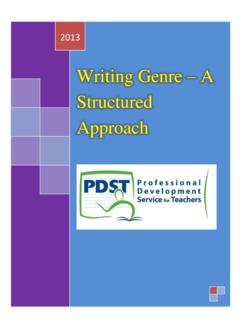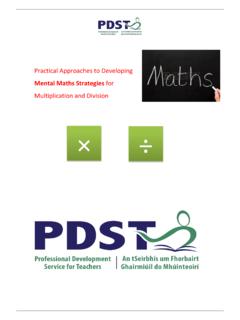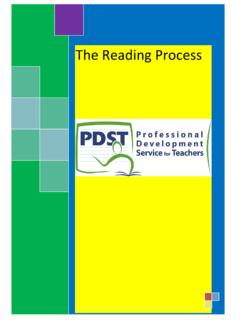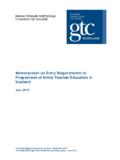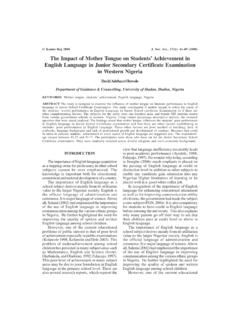Transcription of This manual has been designed by members of the ...
1 This manual has been designed by members of the Professional Development Service for Teachers. Its sole purpose is to enhance teaching and learning in Irish primary schools and will be mediated to practising teachers in the professional development setting. Thereafter it will be available as a free downloadable resource on for use in the classroom. This resource is strictly the intellectual property of PDST and it is not intended that it be made commercially available through publishers. All ideas, suggestions and activities remain the intellectual property of the authors (all ideas and activities that were sourced elsewhere and are not those of the authors are acknowledged throughout the manual ). It is not permitted to use this manual for any purpose other than as a resource to enhance teaching and learning .
2 Any queries related to its usage should be sent in writing to: Professional Development Service for Teachers, 14, Joyce Way, Park West Business Park, Nangor Road, Dublin 12. Shape and Space manual A Guide to teaching and learning in Irish primary Schools 2 This manual has been designed by members of the Professional Development Service for Teachers. Its sole purpose is to enhance teaching and learning in Irish primary schools and will be mediated to practising teachers in the professional development setting. Thereafter it will be available as a free downloadable resource on for use in the classroom. This resource is strictly the intellectual property of PDST and it is not intended that it be made commercially available through publishers.
3 All ideas, suggestions and activities remain the intellectual property of the authors (all ideas and activities that were sourced elsewhere and are not those of the authors are acknowledged throughout the manual ). It is not permitted to use this manual for any purpose other than as a resource to enhance teaching and learning . Any queries related to its usage should be sent in writing to: Professional Development Service for Teachers, 14, Joyce Way, Park West Business Park, Nangor Road, Dublin 12. 3 C ON T EN T S Aim .. 9 Instructional Framework .. 9 Instructional Strategies .. 9 Classroom Culture .. 11 Background Knowledge for Teachers .. 12 Fundamental Facts regarding Shape and Space .. 12 2-D Shapes: Fundamental Facts .. 12 3-D Shapes: Fundamental Facts.
4 13 Symmetry: Fundamental Facts .. 14 Spatial Awareness: Fundamental Facts .. 15 Pupil Misconceptions Involving Shape and Space .. 17 learning Trajectory .. 19 Shape and Space learning Trajectory Level A .. 19 Shape and Space learning Trajectory Level B .. 20 Shape and Space learning Trajectory Level C .. 21 Shape and Space learning Trajectory Level D .. 22 Level A teaching and learning Experiences .. 24 Level : Explore, discuss, develop and use the vocabulary of spatial relations (positional and directional) 24 teaching Notes .. 24 Sample learning Experiences .. 25 Level : Sort, describe and name 3-D shapes including cube, cuboid, sphere and cylinder .. 34 teaching Notes .. 34 Sample learning Experiences .. 36 Level : Sort, describe and name 2-D shapes including square, circle, triangle and rectangle.
5 40 Background Knowledge for Teachers .. 40 teaching Notes .. 40 Sample learning Experiences .. 40 4 Level : Combine and divide 3-D and 2-D shapes to make larger or smaller shapes .. 52 teaching Notes .. 52 Sample learning Experiences .. 52 Level : Use suitable 3-D and 2-D structured materials to create pictures .. 56 teaching Notes .. 56 Sample learning Experiences .. 56 Level B teaching and learning Experiences .. 61 Level : Explore, discuss, develop and use the vocabulary of spatial relations (positional and directional) 61 Background Knowledge for Teachers .. 61 teaching Notes .. 61 Sample learning Experiences .. 62 Level : Describe, compare and name 3-D shapes including cone .. 67 Background Knowledge for Teachers .. 67 teaching Notes .. 67 Sample learning Experiences.
6 67 Level : Sort, describe, compare and name 2-D shapes including square, rectangle, triangle, circle, semicircle, oval .. 69 teaching Notes .. 69 Sample learning Experiences .. 69 Level : Construct, draw, combine and partition 2-D shapes .. 75 teaching Notes .. 75 Sample learning Experiences .. 75 Level : Identify halves and quarters of 2-D shapes .. 79 teaching Notes .. 79 Sample learning Experiences .. 79 Level : Identify line symmetry in shape and in the environment .. 83 Background Knowledge for Teachers .. 83 teaching Notes .. 83 Sample learning Experiences .. 83 5 Level : Explore and recognise angles in the environment .. 87 teaching Notes .. 87 Sample learning Experiences .. 87 Level : Identify and discuss the use of 2-D and 3-D shapes in the environment.
7 89 teaching Notes .. 89 Sample learning Experiences .. 90 Level C teaching and learning Experiences .. 94 Level : Identify, describe and classify 3-Dshapes by comparing their properties including triangular prism and pyramid .. 94 Background Knowledge for Teachers .. 94 teaching Notes .. 95 Sample learning Experiences .. 95 Level : Explore, describe, compare and classify the properties of 2-D shapes including oval and irregular shapes .. 99 Background Knowledge for Teachers .. 99 teaching Notes .. 100 Sample learning Experiences .. 100 Level : Construct and draw 2-D shapes; construct 3-D 103 teaching Notes .. 103 Sample learning Experiences .. 103 Level : Identify, describe and classify 2-D shapes including equilateral, isosceles and scalene triangle; parallelogram; rhombus; pentagon; octagon.
8 108 Background Knowledge for Teachers .. 108 teaching Notes .. 108 Sample learning Experiences .. 108 Level : Combine, tessellate and make patterns with 2-D shapes .. 114 Background Knowledge For Teachers .. 114 teaching Notes .. 114 Sample learning Experiences .. 114 6 Level : identify, draw and recognise line symmetry in the environment and in shapes .. 118 Background Knowledge for Teachers .. 118 teaching Notes .. 118 Sample learning Experiences .. 118 Level : Identify, describe and classify parallel, perpendicular, vertical, horizontal and oblique lines .. 124 Background Knowledge for Teachers .. 124 Sample learning Experiences .. 124 Level : Classify angles as greater than, less than or equal to a right angle .. 127 teaching Notes .. 127 Sample learning Experiences.
9 127 Level : Recognise an angle in terms of a rotation .. 130 teaching Notes .. 130 Sample learning Experiences .. 130 Level : Draw, discuss and describe intersecting lines and their angles .. 132 teaching Notes .. 132 Sample learning Experiences .. 132 Level D teaching and learning Experiences .. 135 Level : Identify and examine 3-D shapes and explore relationships including tetrahedron octahedron .. 135 Background Knowledge for Teachersi .. 135 teaching Notes .. 136 Sample learning Experiences .. 136 Level : Draw the nets of simple 3-D shapes and construct the shapes .. 138 teaching Notes .. 138 Sample learning Experiences .. 138 Level : Tesselate combinations of 2-D shapes .. 141 Background Knowledge for Teachers .. 141 teaching Notes .. 141 Sample learning Experiences.
10 141 7 Level : Classify 2-D shapes according to their lines of symmetry .. 145 Background Knowledge for Teachers .. 145 teaching Notes .. 146 Sample learning Experiences .. 146 Level : Make informal deductions about 2-D shapes and their properties .. 149 Background Knowledge for Teachers .. 149 teaching Notes .. 151 Sample learning Experiences .. 151 Level : Identify the properties of the circle and construct a circle of given radius or diamater .. 154 Background Knowledge for Teachers .. 154 teaching Notes .. 154 Sample learning Experiences .. 154 Level : Construct triangles from given sides or angles .. 158 Background Knowledge for Teachers .. 158 teaching Notes .. 159 Sample learning Experiences .. 159 Level : Plot simple co-ordinates and apply where appropriate.




